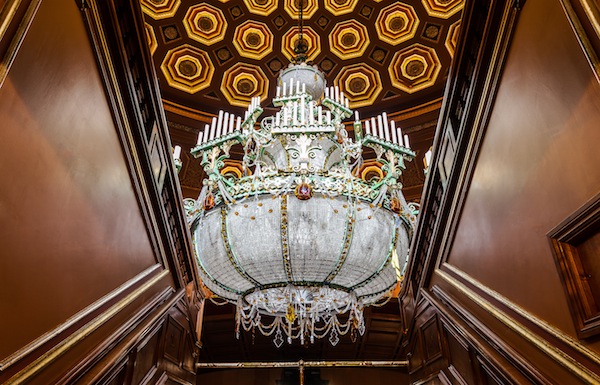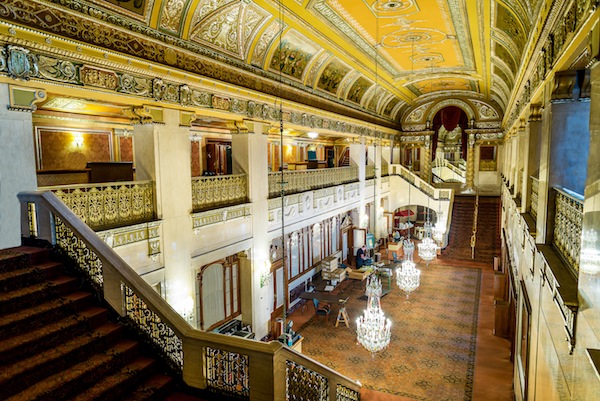“If no one notices, we’re doing our job right,” says John Mumper, facilities manager for the Byham Theater and several other Pittsburgh Cultural Trust buildings.
Mumper spends his days preserving the historic building and ensuring that every detail — from polished light fixtures, to working light bulbs and properly combed carpets — is attended to before patrons even walk in the door.
Hundreds of thousands of visitors flock to Heinz Hall, the Benedum Center and the Byham Theater to see musicals, ballets and symphonies annually, but the building maintenance itself is also “a pretty intricately choreographed ballet,” insists Carl Mancuso, vice president of Heinz Hall.
Spectacular feats
Care for the performance spaces of the Cultural District fall into two categories: annual and day-to-day upkeep. During August, typically the slowest time of the season, the buildings are thoroughly cleaned from top to bottom. Annual maintenance includes some of the largest projects of the year, including cleaning ornate chandeliers.
The Benedum Center boasts a massive 13-foot wide, 22-foot tall chandelier in its auditorium. Weighing in at nearly 2.5 tons, the light fixture is lowered onto the floor using a mechanical winch. Inching down from the ceiling, the glass behemoth looms larger and larger as it moves closer to the floor.
“If you’ve never seen it, it’s a spectacular event,” says Mumper.
Cleaners lay 2×4 boards across the structure of the chandelier so they can climb into the fixture and hand polish each piece of glass. Since it’s not anchored, it swings, sways and rotates as it’s cleaned.
“If you are the slightest bit prone to seasickness, it is not a good job to have,” says Jacob Bacharach, operations manager of the Benedum Center. “It takes a daring individual to climb and navigate through the structure.”
The chandelier is comprised of 50,000 pieces of colored glass that need to be wiped down with gentle soap and water. Each piece is carefully washed then hand dried to prevent streaking.
Shining up the huge lighting fixture requires a total of 80 man-hours.
Heinz Hall, on the other hand, now uses LED light bulbs in its chandeliers. Last year when the 12 Austrian hand-cut crystal chandeliers were lowered in the auditorium, only a single bulb was replaced. Including the four additional chandeliers in the lobby, it can take from three days to a week to clean all of them.
In addition the chandeliers, every sconce, light and detail is wiped down and polished. Some years require more maintenance than others.
The day-to-day maintenance at the Benedum is a different challenge. The theater uses a traditional backlit, hand-lettered marquee. Plastic letters are placed on the marquee one at a time, spelling out the latest show or upcoming production.
The process takes four stagehands, a lift and a shopping cart full of letters.
“Its a laborious process,” explains Bacharach.
It can take upwards of two hours with the crew to re-letter the marquee. The work is slow going as letters are handed to the stagehand in the lift and carefully placed on the marquee. Re-lettering is a weekly, sometimes daily, occurrence.
To ensure proper centering, the production department designed a special computer program that takes into account the size of each letter and it’s placement on the board.
Preserving history
Of the three theaters mentioned, the Benedum is the only registered historical site. However, both the Cultural Trust and Heinz Hall are dedicated to preserving the historic nature of each theater.
“We are trying to maintain a historical aesthetic, relative to light fixtures and paint color choices,” says Mumper. “We’re really interested in keeping that look.”
“It’s a cross between curating a museum and operating a performance arts venue,” adds Mancuso.
For instance, while the chandelier at the Benedum is cleaned, it is also re-lamped and repaired. As a historical site, they use traditional incandescent bulbs, which can be tricky and at times unreliable. Depending on the batch of bulbs, up to 40 percent may burn out by the end of the season.
In 1995, Heinz Hall re-carpeted the entire orchestra level. Luckily, when the carpet was originally purchased in 1971, HJ Heinz purchased double the amount needed and staff was able to use the exact same pattern.
But it’s not always that simple. When repainting walls, the color must be an exact match. This can prove difficult in Heinz Hall, where the marble is actually wood hand-painted to resemble marble.
Painters pay careful attention to the mix of colors and strokes. Engineers and stagehands use 40 gallons of paint annually, on top of the 50 gallons used use by AJ Vater, Heinz Hall’s painting contractor.
“The contractors that work with us are super dedicated to our building,” says Mancuso.
The Benedum Center faced a similar issue when they reupholstered 2,800 theater seats in January 2013. The seats had to match the original lush red velvet upholstery, but nowadays it can be difficult to find the correct fabric.
“Many of the artisanal production and artisans themselves are no longer around, or if they are, they’re difficult to find and pricey,” explains Bacharach.
It took five years to find the right match, and in the end, the material was custom produced.
The reupholstering itself took three weeks. Every seat back and cushion was removed, and all wooden seat backs were stained and refinished.
At the Byham Theater, they found a way to use technology to recreate a vintage aesthetic.
During the renovations in the early '90s, the Byham added a historically accurate marquee to advertise performances. But, in its 18 or so years on the building, the software it used became outdated and bulky.
“It had this ancient computer,” recalls Mumper.
The marquee was replaced in the early aughts with LED technology and newer software. Thanks to the LED system, they can manipulate the color to replicate the original incandescent lights.
Ready for show time
Day-to-day upkeep of the theaters is met with the same enthusiasm as the annual cleanings.
Heinz Hall employs four full-time and four-part time custodial engineers for the 281,000-square-foot space. The entire building is cleaned before every performance. Additionally, a dedicated five full-time and four part-time custodial employees ensures that bathrooms are cleaned multiple times during a single show.
Heinz Hall also employs three full-time engineers. Their duties include maintaining the heating and air conditioning, plumbing, and off-stage electrical systems.
The venues have to take into account the smallest details to ensure a great experience for patrons. The building engineers pay attention to minute details, all the way down to setting the temperature before a performance.
“As you can imagine, the cooling and heating demands are different than most office buildings or residential buildings,” explains Mumper. “In an hour’s time, we go from a very large empty space to the potential of 3,000 bodies sitting in seats.”
Building engineers have to pay close attention to the performance and rehearsal schedule to ensure the perfect temperature, which is more complicated than it sounds.
“Every dancer wants the theater to be 85 degrees,” says Bacharach, “and every audience member wants it to be much cooler…and opera singers? We still haven’t quite figured out what they want.”


